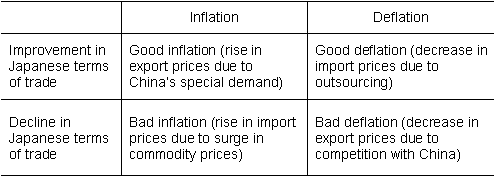Until recently, deflation "made in China" had been considered one of the main culprits behind Japan's lackluster economic performance. If deflation made in China brings trouble, then inflation made in China should be welcomed. However, with the brisk demand from the Chinese economy, a soaring commodity market has raised concerns that inflation made in China might hinder Japanese economic recovery. To solve this contradiction, we need to notice not only the fluctuation of the absolute price level, but also movements of output prices relative to input prices in Japan ( table ). As Japan imports part of its input in the form of raw and intermediate materials from overseas and export part of its output, input prices and output prices follow closely the movements of import prices and export prices, respectively. Thus overseas factors including the rise of China affect the Japanese economy mainly through changes in its terms of trade (export prices relative to import prices).
If Japanese export prices rise relative to import prices, Japan's terms of trade will rise. For Japanese industries, this means that output prices rise relative to input prices, resulting in higher profits as well as production. Here we need to distinguish between "good inflation" and "good deflation." In the case of "good inflation" Japanese export prices rise more than import prices (export prices go up when import prices remain unchanged), while in the case of "good deflation" Japanese import prices fall more than export prices (import prices go down when export prices remain unchanged). For example, "special demand from China" that has boosted Japan's shipping as well as machinery industries is an example of "good inflation made in China." On the other hand, Japanese companies utilizing low labor costs in China through outsourcing such as Uniqlo have benefited from "good deflation made in China."
In contrast, when Japanese import prices rise relative to export prices, the terms of trade in Japan will decline. For Japanese industries, this means that input prices rise relative to output prices, resulting in a decrease in profits as well as production. Here we need to distinguish between "bad inflation" and "bad deflation." In the case of "bad inflation" Japanese import prices rise more than export prices (import prices rise when export prices remain unchanged), while in the case of "bad deflation" export prices in Japan fall more than import prices (export prices decrease when import prices remain unchanged). An example of "bad inflation" is that robust demand from China causes the prices of some commodities, including iron ore, to soar, resulting in rising import prices as well as declining terms of trade in Japan. On the other hand, lower prices of Chinese products due to rising productivity will force Japanese companies that compete with Chinese companies to reduce output prices as well as production. The concerns over "bad deflation" have contributed to Japan's "China threat syndrome."
To reduce the deflationary pressure made in China, Japan has demanded that China revalue the Chinese yuan. A stronger yuan will certainly raise the price of Chinese products in international markets, bringing benefits to Japanese companies that compete with Chinese companies. However, this is "bad inflation" that will cause rising costs and a decrease in production for companies which have enjoyed the benefits of "good deflation" through out-sourcing to China. Given the fact that the relationship of the industrial structure between Japan and China is complementary rather than competitive, deflation made in China is largely "good deflation," and inflation due to a stronger yuan will turn out to be "bad inflation" for Japan.
Table: Deflation and inflation made in China: Four cases



